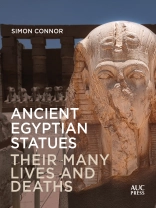A fascinating, richly illustrated study of the role and significance of ancient statues in Egyptian history and belief
Why do ancient Egyptian statues so often have their noses, hands, or genitals broken? Although the Late Antiquity period appears to have been one of the major moments of large-scale vandalism against pagan monuments, various contexts bear witness to several phases of reuse, modification, or mutilation of statues throughout and after the pharaonic period. Reasons for this range from a desire to erase the memory of specific rulers or individuals for ideological reasons to personal vengeance, war, tomb plundering, and the avoidance of a curse; or simply the reuse of material for construction or the need to ritually “deactivate” and bury old statues, without the added motive of explicit hostility toward the subject in question.
Drawing on the latest scholarship and over 100 carefully selected illustrations, Ancient Egyptian Statues proceeds from a general discussion of the production and meaning of sculptures, and the mechanisms of their destruction, to review the role of ancient statuary in Egyptian history and belief. It then moves on to explore the various means of damage and their significance, and the role of restoration and reuse.
Art historian Simon Connor offers an innovative and lucidly written reflection on beliefs and practices relating to statuary, and images more broadly, in ancient Egypt, showing how statues were regarded as the active manifestations of the entities they represented, and the ways in which they could endure many lives before being finally buried or forgotten.
قائمة المحتويات
Acknowledgments
1. Statues Carry the Mark of History
2. Statues in Egypt
3. Bringing a Statue to Life
4. Intentionally Mutilated or Accidentally Damaged?
5. Destroying to Annihilate
6. Remembering to Forget
7. Magic or Ritual Act
8. Restoring, Transforming to Re-activate
9. Dismantling to Reuse
10. Mutilating to De-activate?
Conclusion
Illustration Credits
Index
عن المؤلف
Born in France in 1987, Simon Connor was awarded his Ph D by the Université libre de Bruxelles, Belgium, in 2014. He has worked on various archaeological sites in Egypt, including Luxor, Dahshur, Tanis, and Heliopolis. He was a curator at the Museo Egizio, Turin (2014-2017), an Andrew W. Mellon Research Fellow at the Metropolitan Museum of Art (2017–2018), and an FNRS Research Fellow at the University of Liège (2018–2021). He is the author of various articles and books, including Le statue del Museo Egizio (2016) and Être et paraître (2020).












